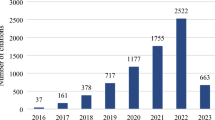Abstract
In this paper the problem of generating integer solutions to the standard one-dimensional cutting stock problem is treated. In particular, we study a specific class of heuristic approaches that have been proposed in the literature, and some straightforward variants. These methods are compared with respect to solution quality and computing time. Our evaluation is based on having solved 4,000 randomly generated test problems. Not only will it be shown that two methods are clearly superior to the others but also that they solve almost any instance of the standard one-dimensional cutting stock problem to an optimum.
Zusammenfassung
In der vorliegenden Arbeit betrachten wir das Problem der Bestimmung ganzzahliger Lösungen für das Standardproblem der eindimensionalen Zuschnittplanung. Insbesondere werden eine spezielle Klasse heuristischer Lösungsverfahren, die in der Literatur beschrieben sind, sowie einige naheliegende Varianten dieser Verfahren vorgestellt. Auf der Grundlage eines numerischen Experiments, bei dem 4.000 Probleme zufällig erzeugt und gelöst wurden, werden die Verfahren miteinander verglichen und im Hinblick auf die Kriterien „Lösungsqualität“ und „Rechenzeitbedarf“ beurteilt. Dabei zeigt sich nicht nur, daß zwei Verfahren deutlich besser als die übrigen einzustufen sind, sondern auch, daß mit ihrer Hilfe nahezu jede Problemausprägung des klassischen eindimensionalen Zuschneideproblems optimal gelöst werden kann.
Similar content being viewed by others
References
Bartmann D (1986) Entwicklung und Einsatz eines DV-Systems zur Auftragsverplanung bei einem Papierhersteller. Angewandte Informatik 12:524–532
Chvátal V (1980) Linear Programming. W.H. Freeman and Company, New York
Diegel A (1988) Cutting Paper in Richards Bay: Dynamic Local or Global Optimization in the Trim Problem. Orion 3:42–55
Dyckhoff H (1981) A New Linear Programming Approach to the Cutting Stock Problem. Oper Res 29:1092–1104
Dyckhoff H (1988) Production Theoretic Foundation of Cutting and Related Processes. In: Fandel G, Dyckhoff H, Reese J (eds) Essays on Production Theory and Planning. Springer, Berlin, pp 191–208
Dyckhoff H (1990) A Typology of Cutting and Packing Problems. Eur J Opnl Res 44:145–159
Dyckhoff H, Finke U (1992) Cutting and Packing in Production and Distribution — A Typology and Bibliography. Physica, Heidelberg
Dyckhoff H, Kruse H-J, Abel D, Gal T (1985) Trim Loss and Related Problems. Omega 13:59–72
Dyckhoff H, Wäscher G (1988) Bibliography of Cutting and Packing. Working Paper, RWTH Aachen, Germany
Eilon S (1960) Optimizing the Shearing of Steel Bars. J Mech Engg Sci 2:129–142
Fieldhouse M (1990) The Duality Gap in Trim Problems. SICUP-Bulletin, No. 5:4f
Garey MR, Johnson DS (1979) Computers and Intractability — A Guide to the Theory of NP-Completeness. W.H. Freeman and Company, San Francisco
Gau T (1993) Die Bestimmung (optimaler) ganzzahliger Lösungen eindimensionaler Zuschneideprobleme auf Grundlage eines Dekompositionsansatzes. Paper presented at the 1993 Joint DGOR/NSOR Conference, 25–27 August 1993, Amsterdam, Netherlands
Gau T (1994) Quasi-exakte und heuristische Verfahren zur ganzzahligen Lösung des Standardproblems eindimensionalen Zuschneidens. Working Paper, Institut für Wirtschaftswissenschaften, TU Braunschweig, Germany
Gau T, Wäscher G (1995) CUTGEN 1: A Problem Generator for the Standard One-dimensional Cutting Stock Problem. Eur J Opnl Res 84:572–579
Gilmore PC (1979) Cutting Stock, Linear Programming, Knapsacking, Dynamic Programming, and Integer Programming — Some Interconnections. Ann Discr Math 4:217–235
Gilmore PC, Gomory RE (1961) A Linear Programming Approach to the Cutting-Stock Problem. Oper Res 9:848–859
Gilmore PC, Gomory RE (1963) A Linear Programming Approach to the Cutting-Stock Problem — Part II. Oper Res 11:863–888
Haessler RW (1975) Controlling Cutting Pattern Changes in One-Dimensional Trim Problems. Oper Res 23:483–493
Haessler RW (1976) Single-Machine Roll Trim Problems and Solution Procedures. TAPPI 59:145–149
Hochbaum DS, Shamir R (1991) Strongly Polynomial Algorithms for the High Multiplicity Scheduling Problem. Oper Res 39:648–653
Kantorovich LV (1960) Mathematical Methods for Organizing and Planning Production. Manag Sci 6:363–422
Marcotte O (1986) An Instance of the Cutting Stock Problem for Which the Rounding Property Does Not Hold. Oper Res Letts 4:239–243
Martello S, Toth P (1990) Knapsack Problems — Algorithms and Computer Implementations. John Wiley, Chichester
Neumann K, Morlock M (1993) Operations Research. Hanser, München-Wien
Pierce JF (1964) Some Large-Scale Production Scheduling Problems in the Paper Industry. Prentice-Hall, Englewood Cliffs
Press WH, Teukolsky SA, Vetterling WT, Flannery BP (1992) Numerical Recipes in FORTRAN — The Art of Scientific Computing. 2nd edn. Cambridge University Press, Cambridge
Rao MR (1976) On the Cutting Stock Problem. J Comp Soc India 7:35–39
Scheithauer G, Terno J (1992) About the Gap Between the Optimal Values of the Integer and Continuous Relaxation of the One-Dimensional Cutting Stock Problem. In: Gaul W et al. (eds) Operations Research Proceedings 1991. Springer, Berlin, pp 439–444
Stadtler H (1988) A Comparison of Two Optimization Procedures for 1- and 1 1/2-Dimensional Cutting Stock Problems. OR Spektrum 10:97–111
Stadtler H (1990) A One-dimensional Cutting Stock Problem in the Aluminium Industry and its Solution. Eur J Opnl Res 44:209–223
Sweeney PE, Paternoster ER (1992) Cutting and Packing Problems: A Categorized Application-Oriented Research Bibliography. J Opnl Res Soc 43:691–706
Wäscher G (1989) Zuschnittplanung — Probleme, Modelle, Lösungsverfahren. Unpublished Postdoctoral Thesis, University of Stuttgart, Germany
Wäscher G (1993) One-Dimensional Integer Cutting Stock Problems. Paper presented at the 1993 Joint DGOR/NSOR Conference, 25–27 August 1993, Amsterdam, Netherlands
Wäscher G, Carow P, Müller H (1985) Entwicklung eines flexiblen Verfahrens für Zuschneideprobleme in einem Kaltwalzwerk, Z Oper Res 29:B209-B230
Wäscher G, Gau T (1993) Test Data for the One-Dimensional Cutting Stock Problem. Working Paper, Institut für Wirtschaftswissenschaften, TU Braunschweig, Germany
Woolsey RED (1972) A Candle to Saint Jude or Four Real World Applications of Integer Programming. Interfaces 2:20–27
Author information
Authors and Affiliations
Corresponding author
Rights and permissions
About this article
Cite this article
Wäscher, G., Gau, T. Heuristics for the integer one-dimensional cutting stock problem: A computational study. OR Spektrum 18, 131–144 (1996). https://doi.org/10.1007/BF01539705
Received:
Accepted:
Issue Date:
DOI: https://doi.org/10.1007/BF01539705




